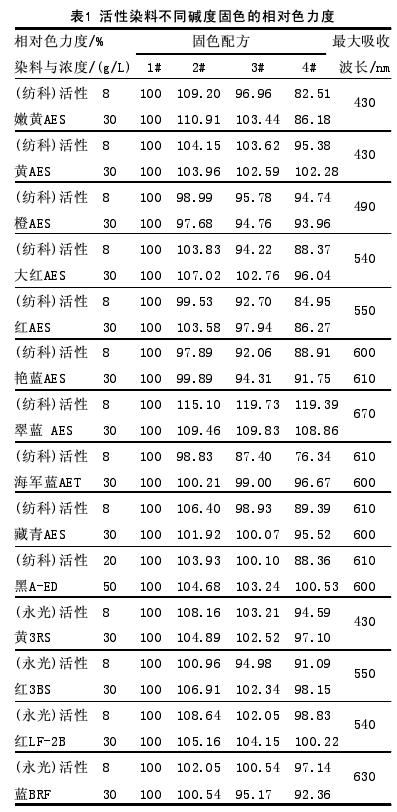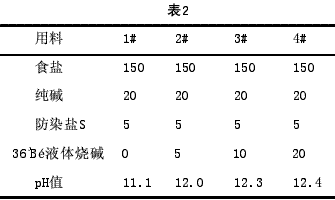Practical Technology for Improving the Stability of Dyed Dyes of Reactive Dyes Cui Haoran (Changzhou Xinhao Printing and Dyeing Co., Ltd., Changzhou, Jiangsu 213003, China)
Abstract: After testing, the reactive dyes with different structures have different requirements for the composition of the steam-fixing bath (especially the amount of caustic soda). Therefore, in actual padding, the composition of the fixing bath must change the "one size fits all" habit, depending on the dye. Otherwise, it will definitely cause the depth of the color to drop, the color and light to fluctuate, and the rework rate to increase.
Key words: reactive dyes; pad dyeing; color stability CLC number: TS 193.632 Document code: AArticle ID:1005-9350(2012)05-0050-03
Medium-temperature reactive dyes, when continuous drying with rolling-rolling steaming, the fixing bath before steaming usually consists of dielectric - salt, alkali agent - soda ash and caustic soda, anti-reducing agent - anti-staining salt S, etc. composition. The anti-staining salt S usually has a reducing gas present in the steaming box. This tends to cause the shade of the reactive dye to become dull (the light color is more pronounced). The anti-staining salt S has weak oxidizing properties and can counteract the effect of the reducing gas on the color shade of the dye.
The role of the dielectric is two (1) the use of dielectric salting in water to reduce the solubility of the dye. Thereby reducing the amount of dye detachment of the preceding (rolling and drying) fabric during the padding and fixing bath. (Note: Among the medium-temperature reactive dyes, many dyes have poor solubility stability in alkaline baths, which are prone to aggregation and flocculation. The aggregates will stain the fabric with the liquid foam, causing color spots and stains. Moreover, the higher the dye concentration, the more serious the problem).
(2) In an alkaline bath, the pH of the solution in the pores of the cellulose fibers is always lower than that of the external phase solution. This has a negative impact on improving the dye-to-fiber fixing rate and fixing rate. The addition of the dielectric can significantly increase the concentration of the internal phase [OH-] of the fiber. Due to the increase in the pH of the fiber internal phase, the degree of negative ionization of cellulose [Call-O-] is significantly increased. Therefore, the dye-fibre fixing speed (relatively lowering the dye-water hydrolysis rate) can be accelerated, and the color depth can be improved.
Therefore, it is necessary to apply a higher concentration of dielectric in the fixing bath. In practice, when the dyeing is light and light, the dielectric is preferably 100-150 g/L; when the dyeing is dark, the dielectric is preferably 200-220 g/L. (Note: Under normal temperature conditions, the saturated concentration of industrial salt is about 300g/L).
The role of the alkaline agent is also two (1) under alkaline conditions, the primary hydroxyl group (-CH2OH) at the C6 position in the cellulose macromolecular chain and the secondary hydroxyl group (-CHOH) at the C2 position, will be negatively ionized [Call -O-], its nucleophilic reactivity is significantly enhanced, so that it is easy to covalently bond with the dye.
(2) Under alkaline conditions, reactive groups in the molecular structure of reactive dyes will produce strong reactivity. Among them, the homotriazine group can produce a nucleophilic substitution reaction with the cellulose anion to produce a cellulose ester. The vinylsulfone group can be reacted with a fiber anion to form a cellulose ether. Thereby the dye molecules become part of the cellulose macromolecules, resulting in substantial dye fastness. Therefore, it is necessary to apply an alkali solution in the fixing bath.
However, there is a technical problem that cannot be ignored here, that is, the pH of the fixing bath must be compatible with the reaction performance of the dye used. Otherwise, it will inevitably lead to a decrease in the fixation rate and a lighter color. The reason is that reactive dyes with different maternal, bridging, and reactive groups have different reaction abilities. Under certain steaming conditions (100-102 ° C, 70-90 s), the most suitable dyes with high reactivity have lower fixing pH values, and the dyes with lower reactivity are most suitable for fixing pH values. If the pH of the fixing bath does not match, the dye is not sufficiently fixed, and the amount of dye hydrolysis is increased, which will have a negative impact on the dyeing result. This can be supported by the following test results. 
Experimental conditions:
(1) Process operation: one dip and one rolling, the rolling rate is 62%. Pre-drying at 80 °C, steaming at 100-101 °C for 90 s, soaping at 95 °C for 5 min, washing with water.
(2) Fixation liquid composition (g/L, mg/L): (3) 100% comparison of the color strength of a single soda ash 20 g/L fixing color by a US Detacolor SF600X colorimeter test. 
As can be seen from the above table:
Commonly used medium-temperature reactive dyes, in the concentration range of 8 ~ 30g / L, most dye varieties are fixed with soda ash 20g / L + 36 ° Bé caustic soda 5mL / L complex alkali, the highest fixation rate, than a single soda 20g / L fixing color, 2% ~ 10% higher.
It is well known that medium-temperature reactive dyes are dip-dyed at lower temperatures (60 ° C) and longer conditions, and the optimum fixing pH is about 11. This is because the negative ion [Cell-O-] concentration of cellulose is relatively high at this time (the ratio of [Cell-O-]/[OH-] is determined to be about 28). Thus, the reaction rate with the dye is relatively fastest. When the pH of the dye bath is >11, the [OH-] concentration in the dye solution increases faster than the [Cell-O-] concentration. Therefore, the hydrolysis rate of the dye gradually increases with the pH of the fixing bath, and the color gradually becomes shallower. Therefore, when the medium-temperature reactive dye is dyed and dyed, it is most suitable to use a single soda ash as a fixing alkali agent.
When the medium temperature type reactive dye is used for continuous padding, although the fixing temperature (100-102 ° C) is increased, the reaction rate of the dye can be greatly improved (it is determined that the reaction rate can be increased by 2 to 3 times by increasing the fixing temperature by 10 ° C). ). However, experiments have shown that the dye-fiber fixation reaction is still insufficient in a short period of time (70 ~ 90s). Therefore, for most dyes, it is necessary to appropriately increase the pH of the fixing bath. That is, it is suitable for soda ash and a small amount of caustic soda as a fixing alkali agent. However, the amount of caustic soda applied must be appropriate, otherwise it will be light due to the increased amount of dye hydrolysis (see table above).
The test results show that the following three dyes have special performance and need attention.
(1) Reactive Brilliant Blue AES, which is most suitable for single soda ash fixation. The complex alkali agent will become lighter in color.
The reason is that Reactive Brilliant Blue AES has a molecular structure equivalent to Reactive Brilliant Blue A(B)-RV and belongs to a monovinylsulfone type dye. It is sensitive to alkali and has strong reactivity. At a lower fixing pH, a higher fixing rate can be obtained. The high pH of the fixing color will cause the color to become light due to the increased amount of hydrolysis.
(2) Reactive turquoise blue AES, using soda ash 20g / L + 36 ° Bé caustic soda 10 ~ 15mL / L higher pH (pH = 12.3 ~ 12.4) fixing color, its color yield is 10% higher than a single soda ash color ~20%.
The reason is that the active turquoise blue AES has a molecular structure equivalent to that of active turquoise blue A(B)-BGFN, and belongs to the copper phthalocyanine vinyl sulfone type dye. It is not sensitive to alkali and has low reactivity. Even at 100-102 ° C, sufficient fixation is achieved within a short period of time (70-90 s). Therefore, a higher fixing pH value is also required.
(3) The active navy blue AET has a dyeing depth of 8-30 g/L and is fixed by a single soda ash (20 g/L), which has the highest color depth. Fixing with soda ash - caustic soda composite alkali, the color depth will decrease greatly with the increase of caustic soda dosage. Moreover, the lower the dye concentration, the greater the decrease.
For example, with active yellow AES 1.6g / L, reactive red AES 0.5g / L, navy blue 0.45g / L, color matching padding 14s × 14s / 60 × 60 cotton cloth, with the solidity bath alkalinity enhancement The color will change significantly. 
Obviously, this is due to the Navy Blue AET. As the alkalinity of the fixing bath increases, the dyeing rate decreases much more than other dyes. This indicates that the active navy blue, whether it is single dye or dyed with other dyes, especially dyed in light color, is only suitable for a single soda ash 20g / L fixing color, and should not be fixed with a composite alkali agent.
If the main color is used as the main color and the deep dye color is mixed with other dyes, the practical amount of 36 ° Bé caustic soda must be accurate and consistent. And it needs <5mL/L.
It can be seen that when the medium temperature type reactive dye is continuously padded, if the fixing agent is used improperly, or the concentration of the fixing bath is unstable (especially the amount of caustic soda applied), the dyeing result will inevitably produce a difference between the depth and the shade.
There is also a technical key to pay attention to, that is, as the continuous padding progresses, the concentration of dyes falling from the rolled fabric to the fixing bath is getting higher and higher. Some dyes with poor salt and alkali resistance, such as reactive turquoise, reactive brilliant blue, active yellow, etc., will agglomerate, and the floc will easily stain the fabric with foam, causing stains on the color spots. This is a chronic disease. It is often difficult to drive).
The experiment proves that applying a proper amount of dispersing leveling agent with small foaming property and solubilizing and solubilizing function and dispersing and spreading function in the fixing bath can effectively inhibit the aggregation of the dye and eliminate or reduce the hidden danger of color spots.
Based on the above analysis, it is reasonable to draw the following conclusions:
(1) The formula of the fixing bath must be determined according to the reaction performance of the dye used, and it must not be cut across the board.
(2) The measurement of the fixing bath ingredients must be accurate and consistent. In particular, the application of caustic soda must be carried out to the same height as the dye.
(3) The fixing bath must be followed by titration with a phenolphthalein-methyl orange double indicator fast titration method. To ensure the stability of caustic soda and soda ash.
(4) A proper amount of a dispersing leveling agent to be applied in the fixing bath. In order to eliminate the hidden dangers of color spots.
Alloy Steel Pipe,Cold Rolled Alloy Steel Pipe,Alloy Steel Tube
Heavy Steel Pipe Co., Ltd , http://www.hzsteelpipe.com